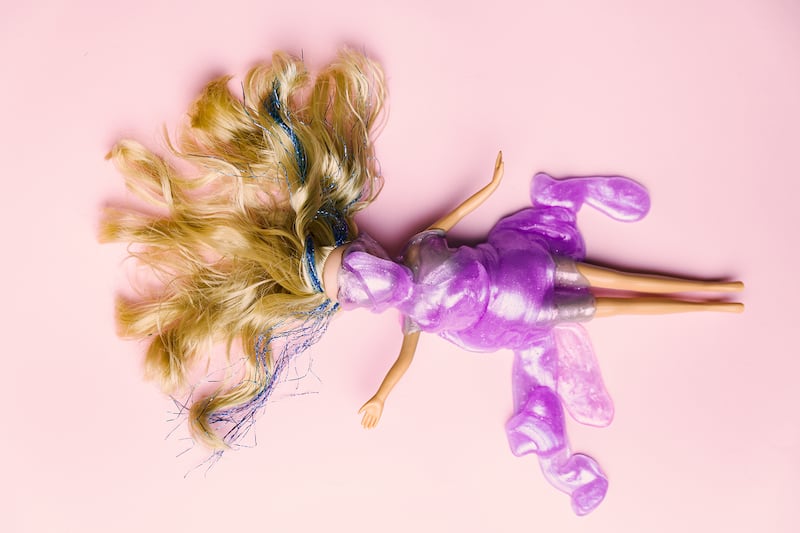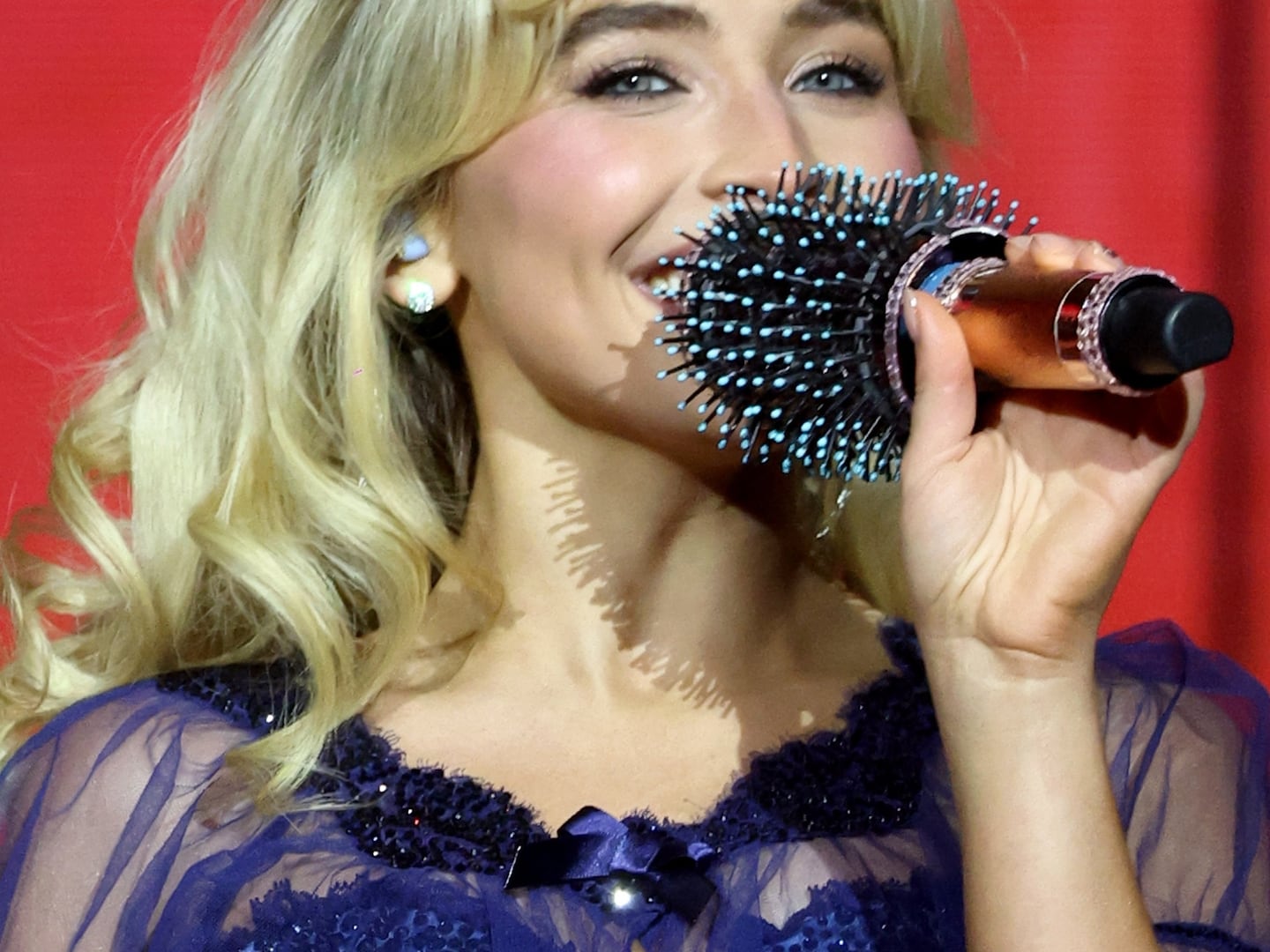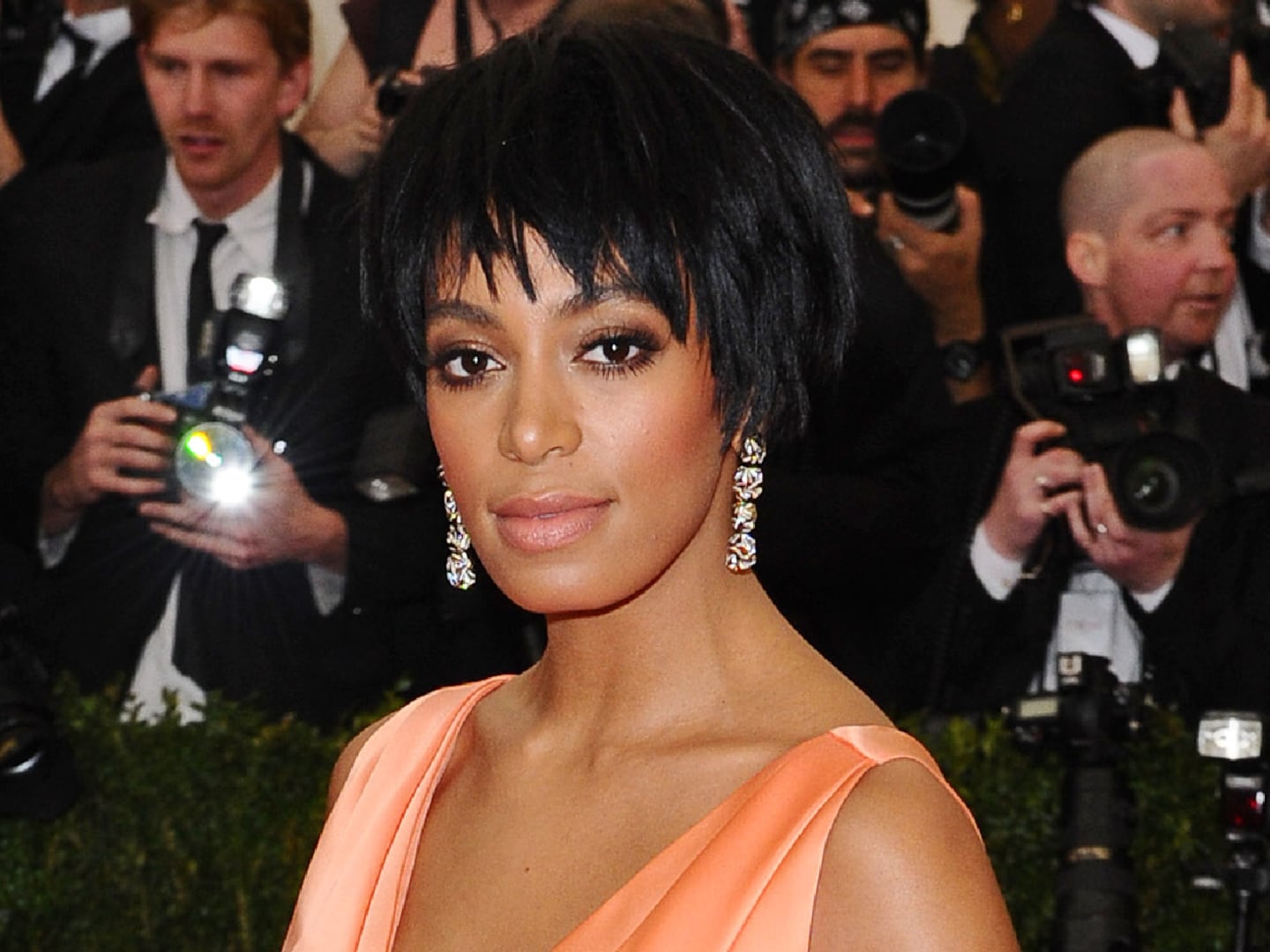It’s Barbie Week at The Daily Beast’s Obsessed, celebrating the doll’s pop-culture history, our favorite Barbie memories, and a certain major movie. Read all of our coverage here!
Of all the Barbies in Greta Gerwig’s jubilant new film—President Barbie, Mermaid Barbie, Sanitation Worker Barbie, etc.—the only one I know for a fact that everyone owned is Weird Barbie. Played by Kate McKinnon, she’s the doll whose owner “played with her too hard.” A quick, haunting flashback clarifies what that means: This Barbie was thrown around, pulled apart, and given a garish makeover, courtesy of scissors and markers.
The other Barbies ostracize Weird Barbie, a moniker they gave their sistren behind her back (and to her face, as they always apologetically admit). There’s no room for a Barbie with imperfect hair and bizarre makeup and who’s always doing the splits in Barbieland; she’s seen horrors that they dare not let infect their pristine, pink world. But that isolation makes Weird Barbie not only hilarious, but also deeply familiar. She’s the Barbie that actually exhibits proof of playtime, who clearly belonged to a little girl we know and most likely were ourselves.
I was hardly allowed to own Barbies as a kid, because each one I was gifted quickly became a member of the Weird clan. While my twin sister and I cherished my Hello Kitty figures and treated my Sylvanian Families toys with utmost care, we found Barbies by turns unimpressive and unseemly. My sister and I saw right through their dead-eyed stares, performative smiles, and unnatural bodies. We had no interest in their stiff, trendy clothes, which we tossed quickly. Instead, we squished these nude ladies’ necks into their sockets, ripped their hair out, and tossed them around the room. Eventually, our mom stopped giving them to us entirely—instead keeping any Barbies gifted to us in their boxes, stuffed in her own closet as “collectibles.”
Our friends did similar things, both alone and with us on playdates. They tossed their dolls across the room or handed them off to devilish little brothers. Together, our young gal pals and I would make Barbie and Ken get up to, shall we say, adult situations; that is, if we even had a Ken around. If not, we would be putting two Barbies into the splits and getting them down and dirty together.
We weren’t alone in misusing—nay, abusing—our Barbies in this fashion. When I asked other former Barbie owners to share their stories of foul play with me on Twitter, I got dozens of validating responses. For as many people who took diligent care of their Barbies, brushing their hair and ensuring they led happy, perfect lives, there were those who saw Barbie as a victim in waiting.
“They were less toys and more chew toys,” says Asher, a 24-year-old from the U.K., of his childhood Barbie collection. “I didn’t really play with them, I bit them. They had gnarled chewed up legs and arms especially, I was mostly uninterested in their heads, and middles are just difficult to get at from a bite perspective.” He’d bite them so much, he says, that “these Barbies looked as if they had been stolen by a dog.”
Several people told me they chewed on their Barbies—when your teeth are still growing in, you resort to all kinds of soothing measures. Alyse, a 30-year-old who grew up in Virginia, puts it well: “I would chew on them absentmindedly, because I chewed on everything as a kid.” Barbie just happened to be among the “everything.”
Other than chewing on Barbie, Alyse says she and her sisters would decapitate the doll. “I thought it was funny, the way their faces kind of deflated when not attached to their bodies,” she says. It gets more disturbing from there: “We had a tub full of decapitated Barbies tucked away into the corner of our living room,” she says—and then she and her sisters would take their deceased Barbie’s accessories and regift them to their other toys.
Similar to Alyse and her sisters, Michelle, a 21 year old from Seattle, would regularly “torture” their Barbies for fun. That involved a hilariously horrifying array of violent acts. Among the things they did to their Barbies were “frying a (roughly anatomically correct) hole in my Barbie’s hips using a magnifying glass, scraping off the decals for her eyes, putting her in water and then freezing her, microwaving her, and cooking her on one of my mom’s nice cast-iron pans, melting her into a grotesque plastic disc, and then when she cooled, throwing her at my sister like a frisbee.”
And then there’s 31-year-old Paige, also from Seattle. She and her siblings went so far as to put her destroyed Barbies on display for her family to “enjoy,” she recalls. “[We] turned our Barbies into macabre tableaus that we called ‘The Barbie Death Museum,’” she says. “There were Barbies in ‘electric chairs’ and ‘guillotines.’ We even made a self-guided audio tour so any guests could have a multimedia experience.” The experience came replete with sound effects making it clear that “Barbie was really dying.” Paige was six years old when this happened, mind you. (Sadly, she didn’t pass along any photos.)
Playing rough is kind of what kids do. But many of the people I spoke to said that they didn’t treat their stuffed animals or other dolls so badly. They all loved collecting Barbie’s accessories, especially her cars and pets. (Veterinarian Barbie was a big hit; she was definitely my favorite too.) But unlike with something as specific as Vet Barbie, says Paige, “I could give my stuffed animals jobs and play out elaborate situations with them… and I couldn’t hug her at night like the stuffed animals.”
Perhaps most importantly, stuffed animals, Sylvanian Families figures, and other types of dolls didn’t have the same cultural connotations attached to them as Barbie did either.
“I had a Mulan doll that was basically a Barbie, but since she’d proved herself as a hardcore warrior and breaker of gender stereotypes, she actually got played with as a doll,” says Michelle.

Even as a kid, Barbie’s adherence to the binary was not lost on Michelle or the other people I spoke to. When asked to reflect upon why they mistreated their Barbies all those years ago, Michelle, Alyse, and Paige each had similar explanations. As young girls rejecting stereotypical notions of femininity, Barbie represented the very thing they refused to be bound by.
“My sisters and I ended up with a ton of Barbies,” says Alyse, “not because any of us particularly liked Barbie, or even dolls for that matter, but because we were a family of three girls.” The automatic birthday and holiday gift—especially in the ’90s—for little girls was a Barbie doll, whether they wanted one or not.
“I resented that,” Alyse continues. “Especially when my male cousins would get cool shit like Hot Wheels and Lego and video games at the same family gatherings. I thought they were boring and shallow and silly, but most of all, I hated that people expected me to like them solely because I was a girl.”
Paige similarly “resented being put in a box, so I resented the doll that represented the box,” she says. As a self-professed young tomboy, she found Barbie’s whole pink schtick grating—and saw right through the idea that Barbie is meant to be a role model for any kind of girl.
“It felt like all her jobs that were supposed to be empowering and inspiring were concessions to pretend she was more than a fashion doll,” says Paige. “They didn’t actually change anything about her except her clothes. It felt like the clothes were the point and the jobs were a trick to make me play with a girly toy.”
Criticisms have long been levied at Barbie for upholding unhealthy beauty standards, with the doll often pointed to as a damaging role model for the children she was marketed to. For much of her lifetime, Barbie was an hourglass-shaped babe, the ultimate girly girl, and the pinnacle of white feminist girlboss-ery. No matter how diverse her array of friends was, Barbie herself was an easy scapegoat for all that was wrong with the patriarchy.
That’s something the Barbie film reckons with, and so has the brand itself in recent years. There are now Barbies of all different body types, skin colors, and hair lengths. But when Paige, Alyse, Michelle, and I were kids, the Margot Robbie-style Stereotypical Barbie still reigned supreme.
But, of course, not all youngsters saw the OG Barbie as the enemy.
“I loved playing with them,” says Natalie, 28. “They were always special birthday or holiday gifts.” Even if she eventually entered her violent-with-toys phase too—she “smashed one of my Disney Princess CDs” and “started violently chewing on Polly Pocket’s clothes” (always with the chewing!)—Natalie was always precious with Barbie. She even idolized her.
“I’d pretend they were really cool teenagers, doing what I thought cool teenagers did at the time,” Natalie says. That entailed “having a tramp stamp and a belly piercing, driving a convertible” to Starbucks, hanging at the mall—innocuous things.
But Natalie’s Barbies also got the Weird treatment. In her and her sister’s case, that meant the requisite terrible haircuts. (“Some of them had to go bald, unfortunately.”) But it also meant that their Barbies were horny.
The Barbies would “make out on occasion… or they’d have sex. I would make them scissor each other, to be specific. I think I thought I had invented scissoring, because it was just what my Barbies would naturally do when they were hanging out together.”
Many young girls played with their Barbies this way. My friends and I absolutely did—but we did so in secret, unable or unwilling to articulate the shame we seemed to feel. In an interview ahead of the film’s release, McKinnon herself implied that she made her Barbies “do some stuff” that was a little adult for her childhood self, while Issa “President Barbie” Rae openly said she used hers “like sex-ed, when I didn’t know what sex was.”
“I blame my latent bisexuality and also The Care and Keeping of You [the iconic American Girl-brand puberty “handbook”],” Natalie continues, when asked to consider why she put her Barbies through the sexual wringer. “And the fact that I watched a ton of raunchy movies at a very young age. I was also obsessed with body parts in general around the time this was happening, and with being a 19-year-old. I simply thought that hanging at the mall and then having lots of sex was how 19-year-olds had fun. I wasn’t wrong!”
That Natalie, my childhood friends, and I played with Barbies this way is nothing to be ashamed of, even if it’s easy to feel sheepish about admitting it.
“This is one of the rarely acknowledged benefits of a doll mostly singled out for her downsides,” wrote Ann Friedman, in an excellent 2014 essay for The Cut (entitled, perfectly, “My Barbies Had So Much Sex. It Was Great”). “Barbie is a safe way for girls to explore dangerously adult concepts like sexuality.” Friedman goes on to cite stories from both her childhood and that of her friends about their dolls’ “active sex life”—something she notes was solely the product of young curiosity, not real sexual intent.
Making your Barbies scissor each other—a very real thing that Natalie did not invent—was a natural impulse, as my former colleague Constance Grady writes in a recent Vox story. “You rip her apart; you make her have sex; what else can you do with her? What else can you do with the problem of what you’re going to grow up to face?”
As grown ups, we can look back at how we turned our elegant Barbies into debauched, disturbed Weird Barbies and laugh. “I can’t help but chuckle thinking about my behavior now, as it’s clear how misplaced my anger was,” says Alyse. “My poor Barbie dolls didn’t do anything to deserve that.”
Despite rejecting Barbie’s femininity and abusing her for it as a kid, Alyse says she’s since done “a 180 started embracing the feminine-coded things I’d pushed away as a kid. My home office is decked out in pink, my Nintendo Switch has an obnoxiously pink case complete with pink cat-paw thumb grips, and I already have my tickets to see the Barbie movie on opening night.”
Michelle also has no regrets about turning her Barbie into a wacky frisbee, saying that “her melted form had the kind of beautiful grotesqueness you sometimes see in modern-art exhibits.”
But for some, the preponderance of Weird Barbies in their collections remains a frustrating memory from growing up as an out-of-the-box little girl.
“I think the main feeling I’ve got is some frustration with how limiting kids’ toys’ gender focus felt,” says Paige. “I’m a cis, straight woman, but even if I couldn’t verbalize it then, I still couldn’t identify with and wasn’t interested in the picture of womanhood she seemed to represent.
“Maybe if I didn’t feel so trapped by the expectation that I’d love Barbies because I was a girl, I wouldn’t have felt so resentful of her and skeptical of her jobs,” she says. “Maybe I would have even liked her.”
Read more of our Barbie coverage HERE.






